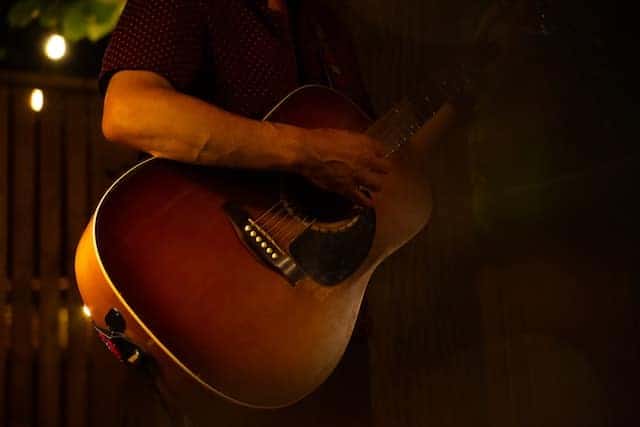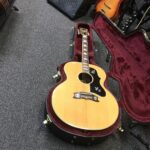What’s the big deal between concert vs dreadnought acoustics?
What are their key differences? Similarities?
Does it even matter which one you choose to get?
The main difference between concert vs dreadnought acoustics all boils down to its size. This automatically changes its inherent volume, tone, and playability. To the trained musician, this spells a world of difference in practical usage and user experience.
This doesn’t mean that each guitar type is musically exclusive.
They both have the same physical components, they still have the same practical value. And you can still play the same things on both types of guitars.
The only difference really is how they sound and feel.
But there’s more to it than that. And that’s what we’re going to find out today!
So read on and find the key differences between concert vs dreadnought acoustics below.
1. Body shape
When it comes to body shape, concert vs dreadnought guitars, the former can be defined as having an iconic shape while the concert has a classier, curvier profile.
A dreadnought guitar typically has a squared-off shape. This is the classic shape most people think about when the word “acoustic guitar” is mentioned.
It’s a simple guitar construction without any frills attached save for some classy inlays for the more expensive offerings from the top brands.
Concert acoustics on the other hand have a rounder profile with a more pronounced waist.
It also appears thinner when viewed from the top or from the side due to its shallower sound chamber.
2. Size
To make it easier to picture the size difference between a dreadnought and a concert acoustic, think of the latter as a dreadnought shrunk down by a quarter of an inch from all sides.
And then shrink it further down at the upper bout and the waist and you have a perfectly resized dreadnought down to concert guitar-size dimensions.
A more technical approach would look like this:
| Measure | Dreadnought | Concert |
| Total body length | 20 inches | 19.5 inches |
| Lower bout | 15.6 inches | 15 inches |
| Upper bout | 11.5 inches | 10 inches |
| Body depth | 4.8 inches | 4.6 inches |
These figures are the generally accepted approximations set by the industry for dreadnoughts and concert guitars.
These figures may vary from manufacturer to manufacturer based on their and their customer base’s desires.
3. Volume
It goes without saying that the dreadnought produces a louder sound than the concert. But this is only true for strummed chords.
When it comes to plucking individual notes, the concert is louder and more articulate than the dreadnought.
One of the main reasons for this is the size of the sound chamber of both guitars.
For the uninitiated, the sound chamber acts as part of the two-step amplification process acoustic guitars have.
What it basically does is collect the sound produced by the strings before pushing it out of the sound hole.
Of the two, the dreadnought has a deeper sound chamber. Therefore, the dreadnought produces a louder volume than the concert guitar in general.
A concert guitar, on the other hand, produces a louder sound per individual string.
The shallower chamber pushes the sound out through the sound hole almost immediately in its purest form without much decay.
Remember also that string tension is another important factor for acoustic guitar volume, and both these models can be strung with different thicknesses sets.
4. Tone
A dreadnought produces a fuller, warmer tone with its deeper sound chamber.
The sound produced by each string reverberates around the chamber longer encouraging the mixture of notes and tones before escaping through the sound hole.
What comes out is a rich sound that is pleasing to the ear.
It is well-balanced with bass, mid, and treble.
This is the reason why dreadnoughts are great for strumming along with.
Concert guitars, with their shallower bodies, tend to push notes out at a faster rate.
The overtones that follow as a result tend to give the concert guitar sound a natural sustain without muddying up the mix.
Concert guitars also produce brighter sounds with reduced bass.
This makes the concert guitar perfect for playing individual notes with your fingers.
5. Target Users
Concert guitars are designed for finger-picking rather than strumming. It produces overtones easier than the bigger, deeper-bodied dreadnought.
So, if you’re a solo player who needs to entertain a small crowd with soft, delicate music, the concert guitar is the one to get.
In full band scenarios, the dreadnought is perfect as it can compete with the louder sounds produced by percussion instruments.
To get a better sound projection, pointing a microphone at the sound hole or plugging it into an amplifier gives the dreadnought an even louder volume.
Concert guitars are also perfect for smaller hands.
The shrunken down body is easy enough for playing while seated or standing for people with smaller hands or children.
It goes without saying that beginners can also benefit from the size difference offered by concert guitars over dreadnoughts.
The ability to play a concert guitar without having to stretch too much encourages longer hours of practice and actual playing.
A dreadnought guitar is perfect for players of all skill levels.
A beginner can start out on a dreadnought with no problem and progress to intermediate or professional levels on the same guitar.
In the end, the value of a guitar becomes apparent with the amount of time it is used, the number of people it amuses or entertains, and how much it encourages musical growth.
This is achieved through both the dreadnought and the concert guitar.
Which One Should You Get?
The most readily available guitars in the market today are dreadnoughts.
Ideally, a concert guitar is the best one to get for smaller hands, children, or beginners. But this doesn’t mean that you can’t start out with a dreadnought.
Over time, the size difference between the two becomes negligible.
What doesn’t change though is the sound produced by each one.
Choosing one over the other can have an immense impact on your development as a guitar player.
You’ll find that you’ll lean towards strumming with a dreadnought and fingerpicking with a concert.
The more you practice either playing style, the more natural it becomes to you.
This is where choosing the right guitar matters the most for you and your musical future.

Hello there, my name is Ramiro and I’ve been playing guitar for almost 20 years. I’m obsessed with everything gear-related and I thought it might be worth sharing it. From guitars, pedals, amps, and synths to studio gear and production tips, I hope you find what I post here useful, and I’ll try my best to keep it entertaining also.





